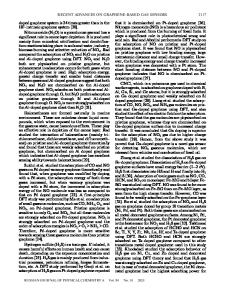Thin film combustible gas sensors based on Zinc Oxide
- PDF / 1,382,416 Bytes
- 6 Pages / 612 x 792 pts (letter) Page_size
- 65 Downloads / 395 Views
Thin film combustible gas sensors based on Zinc Oxide Patrícia Nunes, Elvira Fortunato, Rodrigo Martins Department of Materials Science/CENIMAT, Faculty of Sciences and Technology, New University of Lisbon and CEMOP-UNINOVA, 2829-516 Caparica, Portugal ABSTRACT Sensitivity tests to reductive gases such as methane, hydrogen and ethane were performed on zinc oxide (ZnO) thin films. The highest value of sensitivity was obtained for the film with a high electrical resistivity and a low thickness. The variation of the operating temperature of the film leads to a significant change in the sensitivity of the sensor with an ideal operating temperature dependence of the gas used. The sensitivity of the ZnO thin films changes linear with the increase of the gas concentration. However these films seem to be more appropriated for the detection of hydrogen following by methane and than for ethane since the value of sensitivity obtained are higher and its variation with the gas concentration more pronounced. INTRODUCTION The demand for the environmental and domestic monitoring pollution, lead to a growing interest on solid-state gas sensors. Gas sensors based on the resistance change induced by the gas chemisorption/reactions with adsorbed molecules on the surface, have been widely studied in the last years [1]. Semiconducting oxides are one of the most successful sensitive elements used until now [2, 3], due to the high sensitivity, compatibility with microelectronic, low cost, and the use of simple associated electronics. Tin oxide (SnO2) is one of the most studied materials for application on gas sensors. However in the last year ZnO [4] was emerged as an important material used for gas detection due to its low cost, high stability and etching facility. Gas sensors based on ZnO are sensitive to inflammable gases and in this context, we studied the sensitivity of this material to methane (CH4), ethane (C2H6) and hydrogen (H2). Here, the emphasis was given to the properties of the thin films used and also to the operation conditions of the sensors (working temperature and gas concentration). We also performed Hall effect measurements as a function of temperature with the aim to understand the phenomena responsible for the sensitivity of ZnO thin films. EXPERIMENTAL DETAILS Undoped ZnO thin films were grown on glass substrates by spray pyrolysis at a temperature of 300ºC. The solution used was zinc acetate with a concentration of 0.2M dissolved in methanol. With the aim to obtain films with different thickness and resistivity, the volume of the solution was changed. The film thickness was measured with a Sloan Dektak 3D profilometer. The structural properties of the films were studied using X-ray diffraction spectroscopy on a Rigaku diffractometer having a rotating Cu cathode, and the surface morphology was studied with a scanning electron microscopy (SEM - HITACHI S-4100). The electrical resistivity (ρ) and Hall coefficient were measured at room temperature and as a function of temperature, using the Van der Pauw´s technique in
Data Loading...










